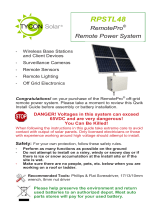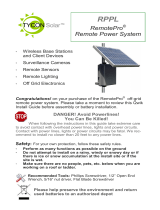Page is loading ...

RPAL MPPT
360W RemotePro®
▫ Wireless Base Stations
and Client Devices
▫ Surveillance Cameras
▫ Remote Control
▫ Remote Lighting
▫ Off Grid Electronics
Congratulations! on your purchase of the RemotePro® Remote
Power System. Please take a moment to review this Qwik Install
Guide before use.
Key Features: Industrial Strength, 48V 60A MPPT solar control-
ler, Outdoor Weatherproof Enclosure, 720-1440Ah Battery, 720-
2160W Solar.
Safety: For your own protection, follow these safety rules.
▫ Perform as many functions as possible on the ground
▫ Do not attempt to install on a rainy, windy or snowy day or if
there is ice or snow accumulation at the install site or if the
site is wet.
▫ Make sure there are no people, pets, etc. below if you are
working on a roof or ladder.
Recommended Tools: Phillips and Small Flat Blade Screwdriv-
ers, 6mm Hex key and 13, 19, 27, 34mm Wrenches
Please help preserve the environment and return
any used batteries to an authorized depot

2
Qwik Install
STEP 1: Select install location where southern sky has no obstructions
that could cause shading on solar panels.
STEP 2: Pour a foundation big enough to hold solar mount anchors
and also provide level support for battery box. See detailed instructions
in solar mount instructions.
STEP 3: Assemble solar array with mount using solar mount instruc-
tions.
Warning: Batteries are very heavy, always use 2 people when
handling the batteries.
STEP 4: Place battery box under solar panels. Install 4-8 batteries in
the box. Use handles to lower batteries into the box. Remove the bat-
tery fuses from the battery cables before proceeding. Connect Bat-
teries in series or parallel configuration depending on your preferred
voltage. See diagrams below.

3

4
STEP 5: Install DIN rail to enclosure using the two screws provided.
Install MPPT solar controller to DIN Rail.
STEP 6: Find the temperature sensor cable that came with the MPPT
Solar Controller and place it on or near the batteries. Connect the bat-
tery cable(s) to the solar controller battery inputs and then to the batter-
ies making sure to observe the proper polarity.
STEP 7: Install the cable glands in the back of the enclosure and route
the long solar panel cables through the cable gland and connect to the
solar controller (PV) inputs. You can shorten the cables as necessary
for a cleaner install. You can also lengthen the cables by adding addi-
tional lengths of 12AWG cable. Please note that the longer the cable,
the more cable loss you will see.
STEP 8: Connect the solar panel pairs in series (Positive to Negative)
by plugging the positive from panel 1 to the negative of panel 2. Don’t
connect the 20’ solar cable to the solar connectors until the MPPT
solar controller is connected to the batteries. The connectors are
keyed for polarity so they cannot be connected incorrectly.
2 Panel Configuration
4 Panel
Configuration

5
STEP 9: Once the batteries and 20’ solar panel cables are connected
to the Solar Controller, connect the batteries by plugging in the fuses
on the battery cables. The solar controller will power up. Now connect
the 20’ cables at the solar panels by plugging in the connectors.
Warning: Battery should always be connected first and discon-
nected last from the controller.
STEP 10: Plug the temperature sensor to the Temp Sensor input on
the MPPT Solar Controller. Refer to MPPT Solar Controller user guide
6 Panel Configuration

6
for additional information
STEP 11: The vent fan is capable of running at 24V or 48V. Connect to
the controller battery connection or direct to batteries.
STEP 12: Tighten the cable glands on the wires to make weatherproof
connections. Plug unused holes using the supplied hole plugs. To plug
an unused cable gland, cut a short piece of wire, insert into the cable
gland and tighten. If desired, attach the enclosure to the solar mount
pole using chain or cable for security.
STEP 13: You may want to put a fine screen over the vent holes on
either end of the enclosure to keep out insects. Window screen works
well. Be sure to secure all cables so they won’t move in the wind. All
cable connectors will be protected by being located under the solar
panels.
TECH CORNER
Additional Information you may find useful
1. CONTROLLER: The MPPT solar controller is capable of 60A into
the solar input and battery output. The load output is capable of switch-
ing up to 30A. The controller is a positive ground type so in a typical
application the batteries should be floating and not grounded. Refer to
the controller user guide for specific information about the controller
operation.
2. Fuse: There is a fuse in-line in the battery cables. If fuse is blown
there was some sort of short in the battery connection and the control-
ler will appear dead. Replace with 3AG 6.3 x 32mm 30A Slo-Blo fuse..
3. VENTING: The enclosure is vented thru a thermostatically (45C)
controlled fan and vents on the ends of the enclosure. You should add
the checking/cleaning of the filters during any routine maintenance cy-
cle but at least annually.
4. BATTERY MAINTENANCE: The batteries used in the RemotePro®
systems don’t require any maintenance. They should last up to 5 years
in normal use. Note: Never store batteries for any length of time in
a discharged state or it may kill the battery, especially during cold
weather. Always fully charge before storage.
5. SOLAR PANEL TILT: There is a solar panel tilt calculator at the
TyconSystems website calculators.tyconsystems.com. We recom-
mend using a fixed tilt and setting to optimize for winter sun. The panel
should face South if you are in the Northern Hemisphere and face
North if you are in the Southern Hemisphere. An easy way to calculate
winter tilt is to take your latitude and add 15 deg.
6. BATTERY OVERDISCHARGE: We highly recommend hooking all

7
equipment loads to the controller load outputs. This output will discon-
nect the loads if the battery voltage drops below the preset level and
this will protect the battery from over-discharge. If batteries get com-
pletely discharged because the equipment was connected directly to
the battery, you will reduce the battery life and you will most likely need
to charge them with a good quality 10A automotive battery charger.
Once they are back to a normal operating range, the integrated charge
controller will maintain the charge. Don’t charge batteries using an au-
tomotive charger for longer than 8hrs or you may damage the battery.
7. TROUBLESHOOTING:
A. The display on the solar controller looks fine but the batteries
aren’t charging? The solar voltage should be higher than the
battery voltage. Check to make sure Solar Panels are wired in se-
ries for 48V configuration.
B. There is no voltage output? If battery voltage is too low the
charge controller will turn off the load outputs. If load current is too
high the load output will turn off automatically.
C. Why is my solar panel voltage so high? Open circuit voltage
on a 48V panel array could be as high as 95V. This is normal.
D. My system turns off at night and comes back on in the morn-
ing? This is a sure sign that the solar panels and/or battery ca-
pacity can’t support the load. You should measure your actual
load and recalculate to make sure you have adequate solar and
battery capacity. Make sure there is no shading of solar panels
during the day. Clean panels. Check tilt.
E. There is no power at the solar controller? Check the battery
cable fuse. Measure battery voltage at the solar controller it
should be >9V. If less than 9V then batteries will need to be
charged with an external charger to bring the voltage up to normal
operating range of the controller.

8
Limited Warranty
The RPAL48 Remote Power System is supplied with a limited 36 month
warranty which covers material and workmanship defects. This warran-
ty does not cover the following:
• Parts requiring replacement due to improper installation, misuse,
poor site conditions, faulty power, etc.
• Lightning or weather damage.
• Physical damage to the external & internal parts.
• Products that have been opened, altered, or defaced.
• Water damage.
• Usage other than in accordance with instructions and the normal
intended use.
Tycon Systems Inc.
14641 S 800 W Suite A
Bluffdale, UT 84065
support@tyconsystems.com
PH: 801-432-0003
SPECIFICATIONS Subject to change without notice
RPAL
Battery Capacity 720Ah - 1440Ah
Rated Load @ peak sun hrs Up to 360W @ 6hrs sun
(RPAL48M-14-2160 system)
Reserve Power @ Rated Load >24 hours
Load Volts/Current(DC) LoadV=BattV , 30A Max
Battery Voltage (DC) 12V / 24V / 48V
Battery Type Valve Regulated Sealed Lead Acid /
Pure Lead Carbon AGM
Battery Life 5 Years
Controller Type 12/24/48V 60A Temp Compensated
MPPT Battery Charge Controller
Over-discharge protection 11V / 22V / 44V
Over-discharge recovery volts 12.5V / 25V / 50V
Controller Self Consumption <1W Typical
Enclosure Type Diamond Plate Aluminum
Operating Temperature -30°C to +60°C
/










